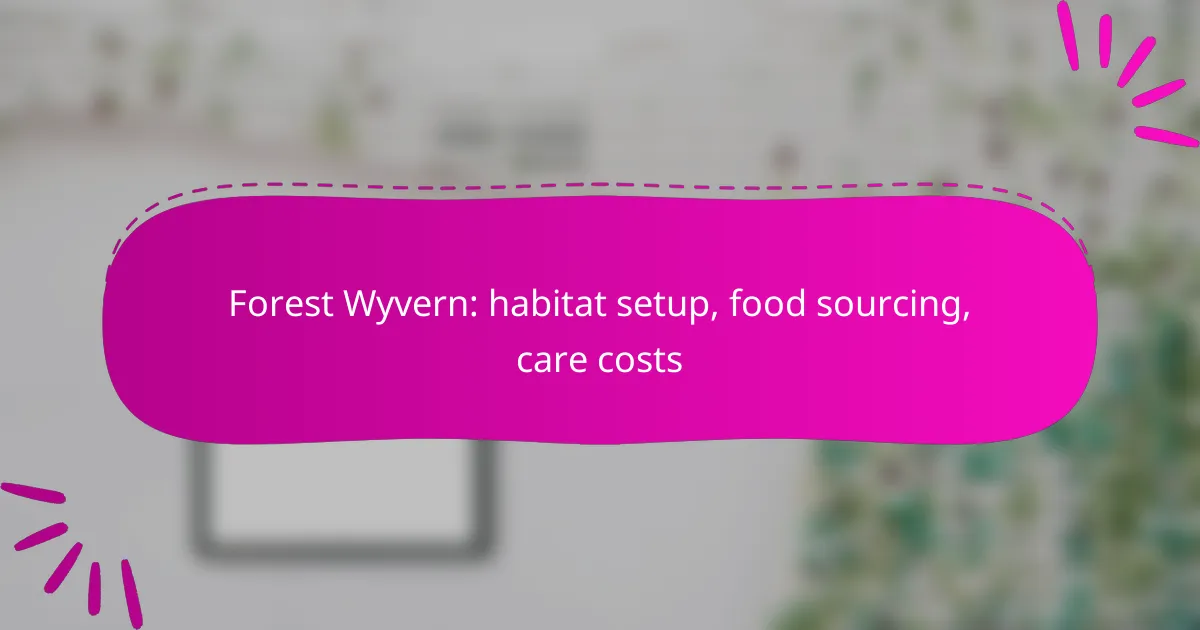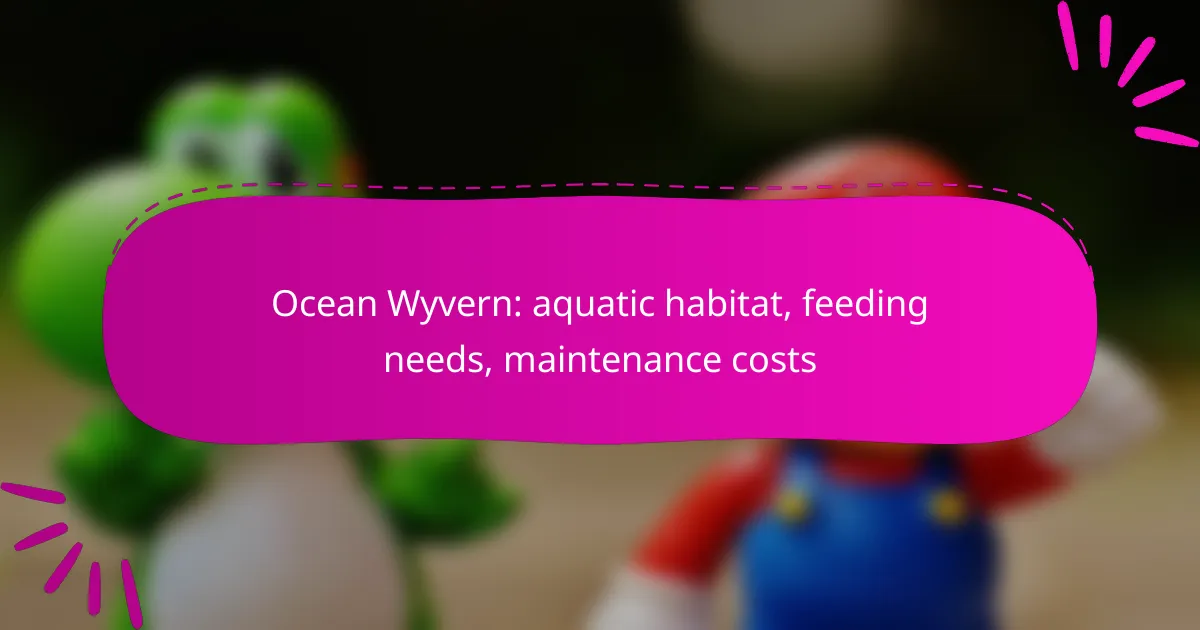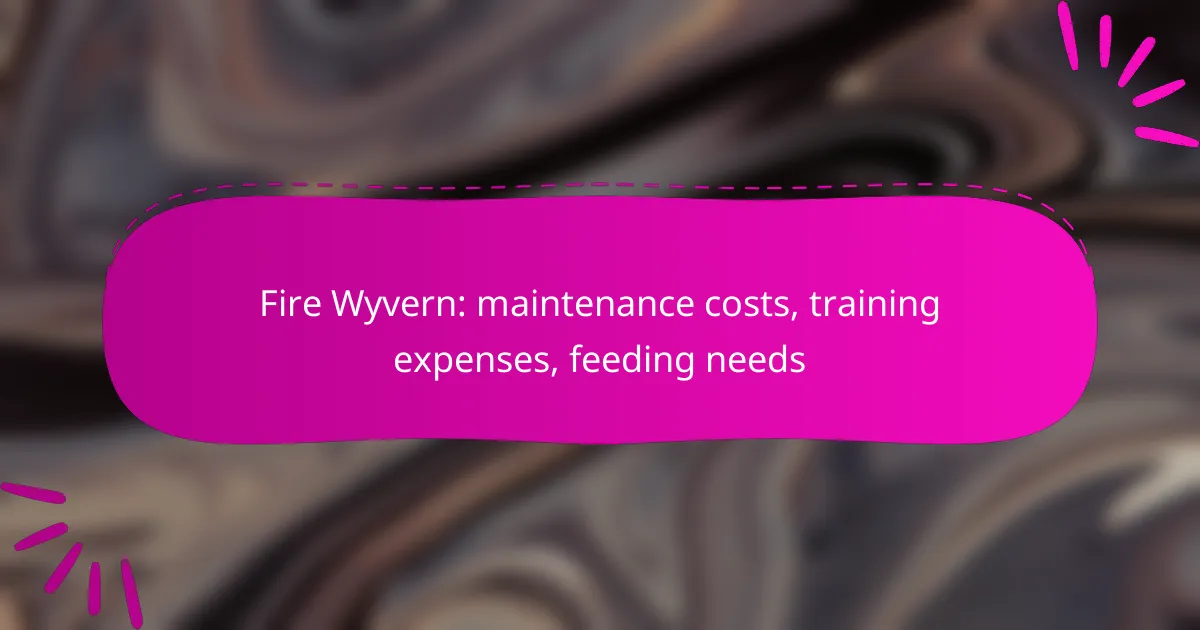Creating a suitable habitat for a Forest Wyvern requires careful attention to detail, including the right terrarium size, temperature, humidity, and enriching decor. Their diet consists mainly of protein-rich foods like small mammals, birds, and insects, which must be tailored to their specific needs. Additionally, prospective owners should be aware that the costs associated with their care can vary widely, making budgeting essential for their health and well-being.

How to set up a Forest Wyvern habitat?
Setting up a Forest Wyvern habitat involves creating an environment that mimics their natural surroundings, ensuring they thrive in captivity. Key factors include appropriate terrarium size, temperature, humidity, and decor that provides both comfort and stimulation.
Terrarium size and materials
A Forest Wyvern requires a spacious terrarium, ideally at least 75 gallons, to allow for movement and growth. Use sturdy materials like glass or acrylic, which can withstand humidity and temperature fluctuations.
Ensure the terrarium has a secure lid to prevent escapes, as these creatures are known for their climbing abilities. Ventilation is also crucial; consider terrariums with mesh tops or side vents to promote airflow.
Temperature and humidity requirements
Maintaining the right temperature is vital for a Forest Wyvern’s health. The basking area should be around 30-32°C, while the cooler side can be maintained at 22-25°C. Use heat lamps or ceramic heaters to achieve these temperatures.
Humidity levels should range between 60-80%. Regular misting and a water dish can help maintain this humidity, but ensure proper drainage to prevent mold growth.
Decor and hiding spots
Providing ample decor is essential for a Forest Wyvern’s well-being. Incorporate branches, logs, and plants to create climbing opportunities and mimic their natural habitat. Live plants can also help maintain humidity levels.
Include hiding spots such as caves or dense foliage where the wyvern can retreat when feeling stressed. This will help reduce anxiety and promote a sense of security.
Lighting needs
Proper lighting is critical for a Forest Wyvern’s health. Use UVB lighting to support metabolic processes and calcium absorption, with a light cycle of 12 hours on and 12 hours off to simulate day and night.
Ensure the UVB light is positioned correctly, as it should be within 30-45 cm from the basking area to be effective. Regularly replace bulbs every 6-12 months to maintain their effectiveness.
Substrate options
Choosing the right substrate is important for both comfort and cleanliness. Options like coconut fiber, orchid bark, or peat moss are suitable as they retain moisture and provide a natural feel.
Avoid substrates that can cause impaction, such as sand or gravel. Regularly clean and replace the substrate to prevent the buildup of waste and bacteria.

What do Forest Wyverns eat?
Forest Wyverns primarily consume a diet rich in protein, favoring small mammals, birds, and insects. Their dietary needs can vary based on their age, size, and activity level, making it essential to provide a balanced selection of food types.
Recommended diet types
Forest Wyverns thrive on a diet that includes high-protein options such as rodents, small birds, and various insects. Additionally, incorporating some fruits and vegetables can provide essential vitamins and minerals. It’s advisable to avoid processed foods and stick to fresh, whole options to maintain their health.
For younger wyverns, smaller prey items are ideal, while adults may require larger portions to meet their energy demands. A varied diet not only supports their growth but also helps prevent nutritional deficiencies.
Food sourcing options
Food for Forest Wyverns can be sourced from local pet stores, specialty reptile shops, or online suppliers that offer live or frozen prey. Many owners also opt to catch insects or small rodents themselves, ensuring the food is fresh and suitable for their wyvern’s needs.
When sourcing food, consider the ethical implications and local regulations regarding wildlife capture. Always ensure that any prey items are free from pesticides and other harmful substances to protect your wyvern’s health.
Feeding frequency
Forest Wyverns should be fed multiple times a week, with younger wyverns requiring daily feedings to support their rapid growth. Adult wyverns can typically be fed every 2-3 days, depending on their size and activity level.
Monitor your wyvern’s body condition and adjust feeding frequency and portion sizes accordingly. Overfeeding can lead to obesity, while underfeeding may stunt growth or lead to health issues. Regularly assess their weight and overall health to ensure they are receiving an appropriate amount of food.

What are the care costs for a Forest Wyvern?
The care costs for a Forest Wyvern can vary significantly based on initial setup, ongoing maintenance, and veterinary needs. Budgeting for these expenses is crucial to ensure a healthy and well-cared-for creature.
Initial setup expenses
Setting up a suitable habitat for a Forest Wyvern involves several key expenses. You will need to invest in a spacious enclosure, which can range from a few hundred to several thousand dollars depending on size and materials. Additionally, consider costs for heating, lighting, and substrate, which may add another hundred to a few hundred dollars.
Other initial costs include purchasing food supplies and any necessary equipment for habitat enrichment. Overall, expect to spend anywhere from $500 to over $2,000 for a comprehensive setup.
Monthly maintenance costs
Monthly maintenance costs for a Forest Wyvern typically include food, utilities for habitat upkeep, and cleaning supplies. Food expenses can range from $50 to $200, depending on the diet you choose to provide. Utilities for heating and lighting can add another $20 to $100 to your monthly bill.
Regular cleaning and maintenance supplies may cost around $10 to $30 monthly. Overall, you should budget approximately $80 to $330 each month for ongoing care.
Veterinary care considerations
Veterinary care for a Forest Wyvern is essential for maintaining its health and well-being. Routine check-ups can cost between $50 and $150, while emergency visits may range from $200 to $500 or more, depending on the severity of the issue.
It’s also wise to consider health insurance for your Wyvern, which can help offset some of these costs. Be sure to find a veterinarian experienced with exotic creatures, as specialized care may come at a premium.

What are the common health issues for Forest Wyverns?
Forest Wyverns can face several health issues, including respiratory problems, skin infections, and nutritional deficiencies. Early detection and proper care are essential to ensure their well-being and longevity.
Signs of illness
Common signs of illness in Forest Wyverns include lethargy, loss of appetite, and abnormal behavior. You may also notice changes in their skin, such as discoloration or lesions, which can indicate infections.
Additionally, respiratory issues may manifest as coughing or wheezing. Regular monitoring of their behavior and physical condition can help catch these signs early.
Preventative care tips
To prevent health issues, maintain a clean habitat and provide a balanced diet rich in essential nutrients. Regular veterinary check-ups are crucial for early detection of potential problems.
Ensure your Forest Wyvern has access to fresh water and appropriate enrichment to promote mental stimulation. Avoid overcrowding in their habitat, as stress can lead to various health complications.

How to choose the right supplies for a Forest Wyvern?
Choosing the right supplies for a Forest Wyvern involves selecting appropriate habitat materials, food sources, and care essentials. Focus on creating a safe and enriching environment that meets their specific needs.
Essential equipment checklist
When setting up a habitat for a Forest Wyvern, ensure you have the following essential equipment: a spacious enclosure, appropriate substrate, heating elements, and humidity control tools. The enclosure should be at least several square meters to allow for movement and exercise.
Additionally, consider including climbing structures, water features, and hiding spots to mimic their natural environment. Regularly check the equipment for functionality to maintain a healthy habitat.
Recommended brands for habitat supplies
For habitat supplies, brands like Exo Terra and Zoo Med are well-regarded for their quality and reliability. Exo Terra offers a range of terrariums and accessories that cater to the needs of exotic pets, including Forest Wyverns.
Zoo Med provides heating and lighting solutions that are essential for maintaining the right temperature and humidity levels. Always read reviews and check compatibility with your specific setup before purchasing.

What are the best practices for breeding Forest Wyverns?
Breeding Forest Wyverns requires careful attention to their habitat, diet, and overall care. Establishing optimal conditions and sourcing appropriate food are crucial for successful breeding and healthy offspring.
Breeding conditions
Forest Wyverns thrive in environments that mimic their natural habitats, which typically include dense forests with ample foliage and space for nesting. A temperature range of 20-25°C (68-77°F) is ideal, along with high humidity levels to support their skin health and hydration needs.
Ensure that the breeding area is spacious enough to accommodate the wyverns’ activity levels and social behaviors. Providing hiding spots and perches can reduce stress and promote natural behaviors, which are essential for successful breeding.
Food sourcing
Feeding Forest Wyverns a balanced diet is vital for their health and reproductive success. They primarily consume small mammals, birds, and insects, which should be sourced from reputable suppliers to ensure quality and safety. A varied diet helps maintain their health and supports breeding efforts.
Consider supplementing their diet with vitamins and minerals to enhance fertility and overall well-being. Regularly monitor their food intake and adjust portions based on their activity levels and health status to prevent obesity or malnutrition.
Care costs
The costs associated with breeding Forest Wyverns can vary widely based on habitat setup, food sourcing, and veterinary care. Initial setup costs for a suitable breeding environment may range from a few hundred to several thousand dollars, depending on the complexity and size of the habitat.
Ongoing expenses include food, which can run into the low hundreds of dollars monthly, and veterinary care, which is essential for maintaining the health of both the adults and their offspring. Budgeting for unexpected medical expenses is also advisable to ensure comprehensive care throughout the breeding process.










